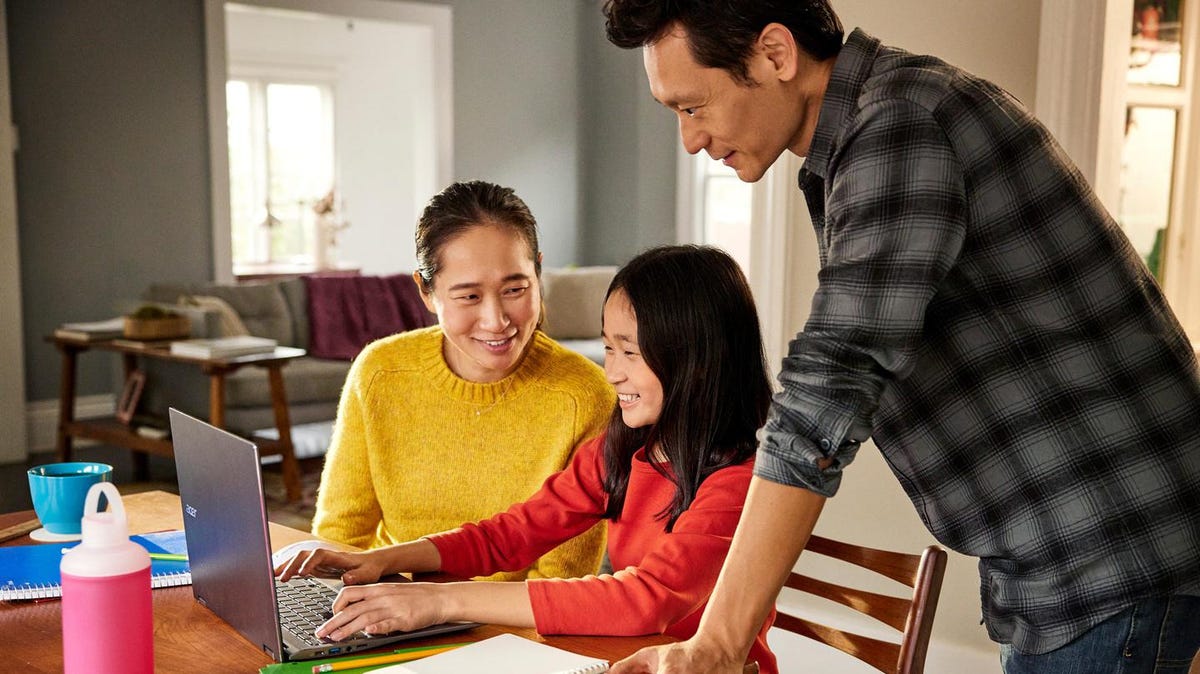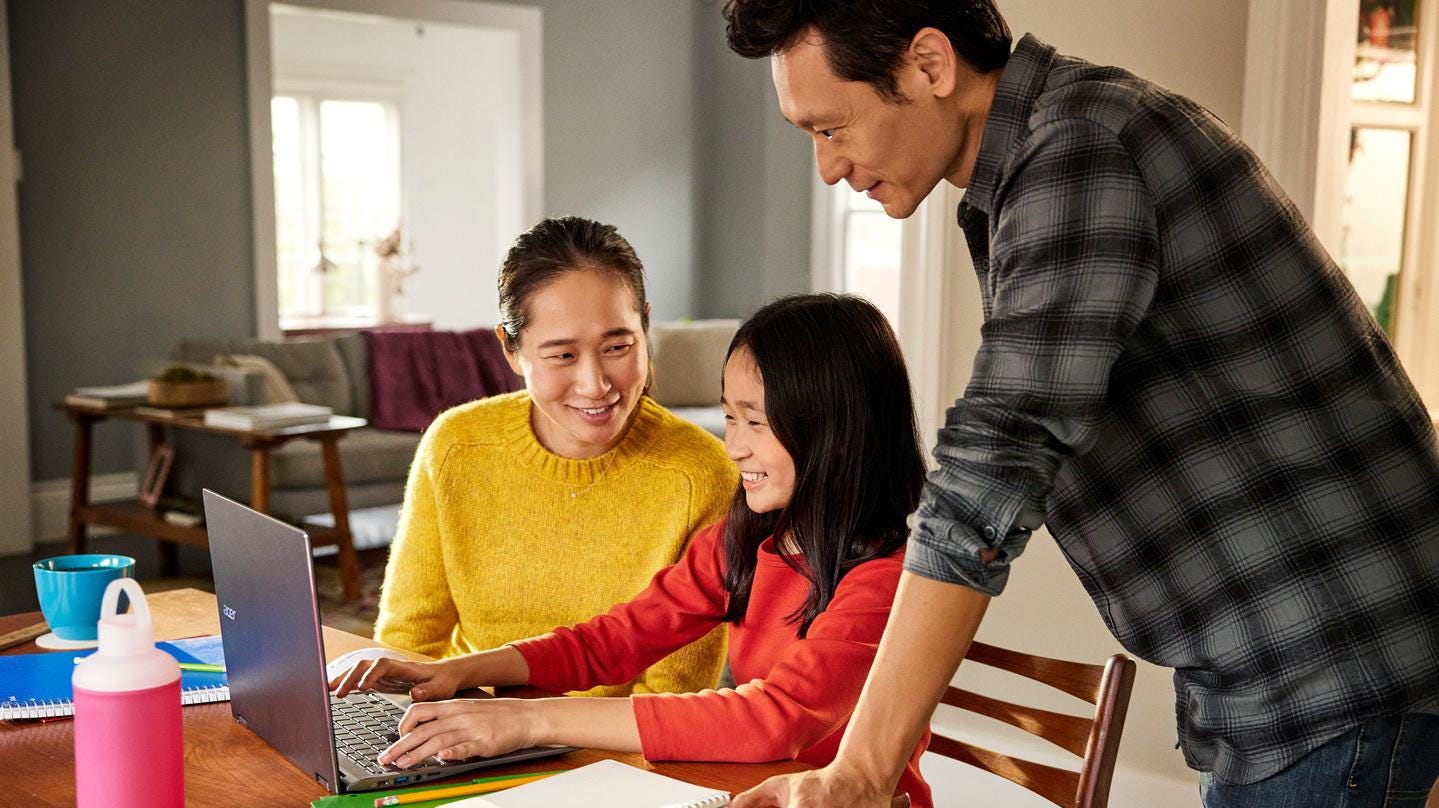
Make online, hybrid, and in-the-classroom education as immersive, effective, and inclusive as possible
Here are the five lessons we’ve learned from distance and hybrid learning that empower us to make education as immersive, effective, and inclusive as possible.
Google for Education
Like many parents and guardians, I felt unprepared to take over the day-to-day management of my household’s learning during the pandemic. Despite being involved in online education for over a decade—first as the founding president of Khan Academy, and now as the product and UX director of Google for Education—I wasn’t ready for the challenges of this past year.
My wife is a physician and because she continued to work outside the home, I had the job of keeping our three boys, including a young kindergartner, on task during their respective school days. As many of us experienced, that also meant that I was ad hoc tech support, short order cook, and the one to jump off a virtual work meeting if I had to encourage or console a young, frustrated learner. Things got better, of course, especially as hybrid learning became possible and as we all got better at juggling everything. But “the pandemic year” gave me a whole new appreciation for what educators and students achieve together every day.
At Google, we’ve spent much of the past year listening to educators, students, and families—from pre-K to Ph.D.—about what’s worked, and what hasn’t, in navigating remote and hybrid learning during a very challenging time. According to UNESCO, more than 1.5 billion students around the world were forced out of their typical school settings and the majority participated in online and distance learning. There’s never been a more disruptive trend in global education and it prompted new and critical conversations about the role of technology, access to its benefits, and all the ways that education relies on human connection.
With this context in mind, here’s what we’re learning from the experience of distance and hybrid learning.
We’ve seen an increased rate not only in the innovation of technology, but also in the resourcefulness of educators to meet their students’ needs
Google for Education
Teachers took resourcefulness to a new level during the pandemic
Table of Contents
- 1 Teachers took resourcefulness to a new level during the pandemic
- 2 The technology conversation in education changed for good
- 3 There’s no substitute for in-person human connection
- 4 The next decade will see innovation accelerate
- 5 Being remote put a spotlight on accessibility gaps and the digital divide
For those of us who are parents, we probably already knew that our kids have some incredibly resourceful classroom teachers before the pandemic upended education as we know it. But more than a year of remote learning revealed that teachers are ingenious at finding ways to support students through any challenge, even from a distance.
I was amazed by their willingness to find creative solutions to meet their students’ needs. Sometimes that meant building lesson plans in Slides, brainstorming with students in Jamboard, or recording their own demo videos. Sometimes it meant rethinking the balance between group collaboration and individual focused work on a new digital platform, and then showcasing student projects with online Scrapbooks. Sometimes it meant putting together a teacher toolkit for using Google Classroom and then sharing it with the world to help educators everywhere.
Teachers did it in countless ways—from developing creative solutions to bridge the distance with their students and families, to empowering their communities with the best of what digital learning has to offer.
The technology conversation in education changed for good
Few would argue with the idea that every primary and secondary student has the right to the resources and technology they need to be successful, whether it’s a library, a computer, or an Internet connection. But as we all know, access to resources and technology differs widely—across the globe, certainly, but also across regions, cities, and even neighborhoods. As terrible as the pandemic has been, it’s forced education leaders and governments to take a step back and rethink how they are providing learning opportunities for every student.
Individual countries and states had different responses to the forced closures of schools based on how far along they were on their technology enablement journey. In Japan, the entire country went online for primary and secondary education, thanks to the government’s US$4B education initiative announced in 2019 to deploy a device to every child in grades 1 through 9. We’re proud that Chromebooks and Google Workspace for Education have been an important part of that evolution, helping millions of Japanese children kickstart their digital learning journeys.
The state of Mississippi, which has historically struggled to meet the technology needs of its schools, was able to rally its legislature and pass a $200 million bill that, among other things, distributed 325,000 Chromebooks to school districts across the state and spurred new initiatives to better equip teachers with best practices for technology use in online and hybrid learning environments.
Getting more devices into the hands of students is, of course, only part of a complex equation. But I’m hopeful education leaders will also invest in reimagining the role of technology at a more holistic level.
There’s no substitute for in-person human connection
Learning happens in all the places that life happens一at home, in the grocery store or park, in the classroom, and everywhere in between. But what happens when the in-person network surrounding that learning suddenly contracts? Without the ability to connect in person with their students, educators had to find new ways to check in on their students’ social and emotional wellbeing. And they did just that.
In a recent survey from the EdWeek Research Center, 61% of district leaders and educators cited supporting the mental health and overall wellbeing of students as a top priority for learning recovery and 67% said they anticipate increased spending on social-emotional learning in their 2021-22 budgets.
I was inspired by all the resourceful ways teachers reached out to students to check on and help manage wellbeing and social-emotional health一from anonymous Forms surveys to polls in Classroom and Meet to mental health and wellbeing resources from Headspace. There was also a surge in discussion about race, equity, and inclusion aided by resources from the Conscious Kid, and we saw tools like GoNoodle, Nearpod, Classcraft, and ClassDojo being used even more to connect and help maintain wellbeing virtually. We saw Google Meet being used for conferences between teachers and parents or guardians, and for group study sessions and clubs. So many teachers made regular one-on-one check-ins with their remote students a priority, even as their own lives were being upended.
Most students—and definitely younger students—learn best and develop social bonds when they’re in-person with their peers and a teacher.
In general, I think we collectively made distance learning more immersive during the pandemic, and we also found new ways to support it with a wider range of resources and strategies that enable student success and wellbeing. But there is no substitute for in-person human connection. Most students—and definitely younger students—learn best and develop social bonds when they’re in-person with their peers and a teacher. Despite all the ways we found to bridge the gaps with technology this past year, most of us are very much looking forward to the in-person human connection that comes to life in a classroom.
The next decade will see innovation accelerate
While education systems leaned heavily on technology this past year, the technology hadn’t fully caught up with changing user needs. We spent a significant amount of time evolving our tools to meet the moment, whether that meant adding Breakout rooms to Meet, improving the mobile experience for Classroom, driving more helpful search in education, or expanding availability of our reading assistant for K-3 students in Read Along.
We also saw many of our customers accelerate their rate of innovation, especially when it came to tapping the speed and availability of cloud tools and machine learning to deliver breakthrough solutions to educators and students.
Penn State World Campus had the foresight to invest in improving virtual advising before the pandemic took hold and they saw massive dividends on their decision during the expansion of virtual learning. The advising team supports over 11,000 students taking classes around the world. Before they implemented a cloud and machine learning advising solution, they spent an average of 15- 30 minutes researching most student queries (like how to change majors and courses). Now students can submit their questions 24/7 online and the virtual agent can answer 87% of them within seconds. This has freed up advisors to spend their time helping the students who need it the most, which was especially important during the pandemic.
This kind of approach isn’t just happening at universities serving a global student population. It’s also happening at the local level. The Upper Grand District School Board in Canada pivoted to an online learning program last year, only to encounter an unprecedented number of inquiries from students who were new to online learning. Within three weeks, they were able to build a virtual agent trained on queries related to online safety and technical support, resolving roughly a thousand queries a day with about 92% accuracy.
As people and organizations lean on technology as in the above examples, we’re going to continue to see tremendous innovation this next decade, including new applications of machine learning and cloud tools.
Being remote put a spotlight on accessibility gaps and the digital divide
Students with special needs were hit especially hard by the pandemic, as their families grappled with supporting their needs without the resources of an in-person classroom. One of the unintended benefits of relying on technology so much this past year was that educators looked for creative solutions to stay connected and keep their students engaged. Meeting students where they are, with the modality that makes the most sense, became an important part of the distance learning equation.
In Portage Public Schools in Michigan, teachers used their Chromebooks to record lesson introductions and included closed-captioning in Google Meet to make sure that deaf and hard of hearing students and families could watch the videos in their own time, and at their own speed. Meanwhile, in Korea, 100 teachers worked together to create an e-learning hub using Google Sites in response to school closures. The hub quickly bridged the gap for multicultural families, serving up content in seven languages, and took a focused approach to providing thoughtful content for students with special needs. As Choi Jee Hae, a special needs teacher put it, “In the epidemic situation, it was very clear that students in special education were placed in the blind spot of learning. However, seeing how I solved and connected, one student at a time through EduTech, I saw hope.”
Prior to the pandemic, between 15 and 16 million US students out of
50 million total lived in a household that lacked either Internet access, a digital device, or both, according to a report from Common Sense Media.
While efforts like these helped with accessibility gaps, the pandemic also shone a spotlight on the digital divide and the education gap. New research suggests that many students fell behind in math and reading, especially Latino and Black elementary students, due to the disruptions of the pandemic. And the digital divide remained a major barrier to student success. Prior to the pandemic, between 15 and 16 million US students out of 50 million total lived in a household that lacked either Internet access, a digital device, or both, according to a report from Common Sense Media. The same was true for between 300,000 and 400,000 public school teachers, or slightly less than one out of every ten nationwide. The majority of those 15 to 16 million students—between 55 and 60 percent—lacked both an internet connection and a digital device.
I believe it’s the responsibility of corporations, governments, and educational institutions everywhere to invest in closing the education gap and the digital divide. We can invest in broadband and internet programs through government funding, scale up the supply of devices to the students most in need, and invest in making applications work better on mobile, since many students around the world have access to some sort of mobile device.
As we chart a course to make online, hybrid, and in-the-classroom education as immersive, effective, and inclusive as possible, we shouldn’t forget that many students and communities are still stuck on the sidelines. At Google for Education, we’re committed to investing robustly in giving educators the tools they need to bring every child or adult learner into the heart of learning–wherever it happens.
Enhance learning, communication, and collaboration in your school communities with easy-to-use tools for learning through Google Workspace for Education.







